- Joined
- 27 December 2005
- Messages
- 16,415
- Reaction score
- 18,957
I expect it was, otherwise why bother doing it?
1602 had larger span wings with a fold.
1602 had larger span wings with a fold.
Bill S said:Several interesting things about this image.
1. Model 18 on the vertical does anyone know if this was a General Dynamics designation?
2. The twin AIM-9 mounting on the wing tips.
3. The AIM-9 mounted on the side of the intake. I don't recall seeing this in any of the drawings.
VAHF image.
Pioneer said:The pic looks like a frame from a film.
Pioneer said:Nice find! Nice pic Bill S
The pic looks like a frame from a film.
If so wouldn't this be a fascinating video to watch and hear!! Imagine hearing the design prospects of the Model 18 philosophy!!!
Regards
Pioneer
What "development"? Only pre-design work was done; to support the proposal effort.
Full Scale Development (where the really hard work happens) was never accomplished as this design was not selected by the Navy.
Edited for clarity.
Isn't that why they were planning on using the f-401 instead?What "development"? Only pre-design work was done; to support the proposal effort.
Full Scale Development (where the really hard work happens) was never accomplished as this design was not selected by the Navy.
Edited for clarity.
The difficulty with turning the YF-16 into NACF was that it really needed to get bigger, but there was no easy path to get more power out of the F100, which was easier for the YF-17 with its not-yet-finalised J101 (F404) engines. In my opinion McDonnell-Douglas basically designed a new aircraft with a resemblance to the YF-17 while Vought tried to actually make a naval fighter derivative of YF-16 with the minimum of changes.
Vought proposed F100, F401 and F101 versions, but F401 was effectively canned at this point as the F-14 was sticking with TF30, and F101 distinctly larger and optimised for a bomber, so there was no engine commonality to leverage. Perhaps a redesign around twin J101 engines would have had a better chance at success, but it would be hard to make it look like a YF-16 derivative. By contrast the F-18 used essentially the same engines with a minor thrust boost.Isn't that why they were planning on using the f-401 instead?What "development"? Only pre-design work was done; to support the proposal effort.
Full Scale Development (where the really hard work happens) was never accomplished as this design was not selected by the Navy.
Edited for clarity.
The difficulty with turning the YF-16 into NACF was that it really needed to get bigger, but there was no easy path to get more power out of the F100, which was easier for the YF-17 with its not-yet-finalised J101 (F404) engines. In my opinion McDonnell-Douglas basically designed a new aircraft with a resemblance to the YF-17 while Vought tried to actually make a naval fighter derivative of YF-16 with the minimum of changes.
I'm not seeing how all those weren't issues especially as the f-18 paradox is such a bad book i automatically think the opposite of what ever the book said.No mention has been made yet of the title "The Pentagon Paradox: The Development of the F-18 Hornet" (ISBN: 9781557507754) by James P. Stevenson. Chapter 10 covers the development of the naval F-16 variant, see attachment. The Navy rejected the naval F-16 for the following points which are expanded upon the the chapter:
a) Tail angle clearance which would cause tail strikes when landing on the carrier
b) High approach speed to perform the "popup" maneuver
c) The fly-by-wire system was not acceptable without a mechanical back-up system
d) Sparrow requirement - having it verses not having it
The Navy played the F-111 game with requirements again.
Where does the "bad book" reputation come from? Yes, it might not be the best idea to use it as sole source for reference material, but it seems quite good to me. Especially the chapter provided here seems quite spot on - it wasn't a Navy program so the Navy were fighting tooth and nail to make a naval F-16 variant fail.I'm not seeing how all those weren't issues especially as the f-18 paradox is such a bad book i automatically think the opposite of what ever the book said.No mention has been made yet of the title "The Pentagon Paradox: The Development of the F-18 Hornet" (ISBN: 9781557507754) by James P. Stevenson. Chapter 10 covers the development of the naval F-16 variant, see attachment. The Navy rejected the naval F-16 for the following points which are expanded upon the the chapter:
a) Tail angle clearance which would cause tail strikes when landing on the carrier
b) High approach speed to perform the "popup" maneuver
c) The fly-by-wire system was not acceptable without a mechanical back-up system
d) Sparrow requirement - having it verses not having it
The Navy played the F-111 game with requirements again.
The bad book reputation comes from it agnoring huge parts of its sources that don't fit his narrative, in this particular case just twisting pretty huge issues issues into non ones.Where does the "bad book" reputation come from? Yes, it might not be the best idea to use it as sole source for reference material, but it seems quite good to me. Especially the chapter provided here seems quite spot on - it wasn't a Navy program so the Navy were fighting tooth and nail to make a naval F-16 variant fail.I'm not seeing how all those weren't issues especially as the f-18 paradox is such a bad book i automatically think the opposite of what ever the book said.No mention has been made yet of the title "The Pentagon Paradox: The Development of the F-18 Hornet" (ISBN: 9781557507754) by James P. Stevenson. Chapter 10 covers the development of the naval F-16 variant, see attachment. The Navy rejected the naval F-16 for the following points which are expanded upon the the chapter:
a) Tail angle clearance which would cause tail strikes when landing on the carrier
b) High approach speed to perform the "popup" maneuver
c) The fly-by-wire system was not acceptable without a mechanical back-up system
d) Sparrow requirement - having it verses not having it
The Navy played the F-111 game with requirements again.
But I agree with Overscan that the YF-17 starting point was better for what the Navy wanted. PP more or less also mentions it. The crux of that chapter is just it's ironic that (like multiple aircraft before it) they made exceptions or adjustments when it suited them (F-14 & 18), but weren't open to the same when it wasn't "their" program ala F-111B or F-16N. Not that the end products were bad aircraft at all.
My guess is on the fixed wing version, no folding tips, it was done to minimize the span for storage on board the carrier. For the larger 1600 models, with the folding wings, it was probably done to minimize weight. The wing fold mechanism wouldn't have to be as robust as a result of not having the missile on the tip, which would make the wing fold lighter.Not sure if this has been mentioned before. Is there any reason the navalised F-16 design moved its wingtips missiles to hanging below the outmost racks? F/A-18 have wingtips missile as well and it doesn't seem to have any issue.
Actually, the standard F-16 has an outstanding internal fuel fraction as a result of the blended wing body.I thought the navalized F-16 had an extension of the fuselage. F-8 was a skinny frame compared to YF-17 and the later F/A-18, yet held a large fuel storage capacity. The basic F-16 design was similar to A-7/F-8, but its short body limited onboard fuel. Perhaps it should have pushed for maximizing fuel, kept chin-racks for Sidewinder, and mounted fore-canards (rather than simplifying to a larger LERX) to maximize nose-pointing. More or less an off-shoot of F-8esque form, minus the tilt-wing, and going with the fore-canard for offsetting an obvious shift in weight from adding the radar. You could therefore retain Sidewinders on the chins without interfering with wing loads.
I have two original drawings of the V-1600 from LTV artist Merle Soule. Does anyone know a market for these? Please text me 214-793-8060
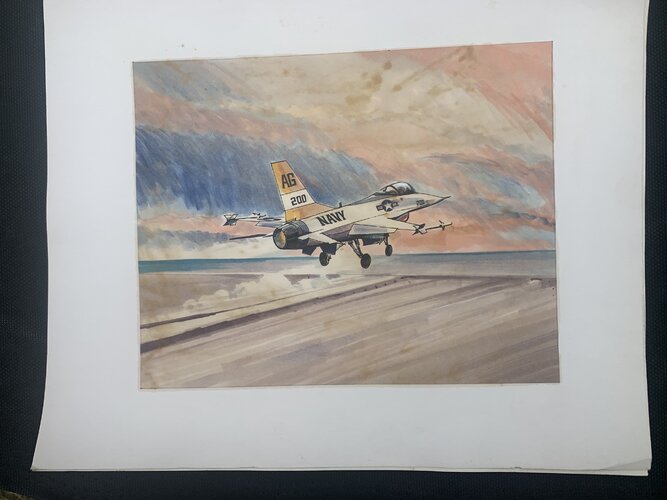
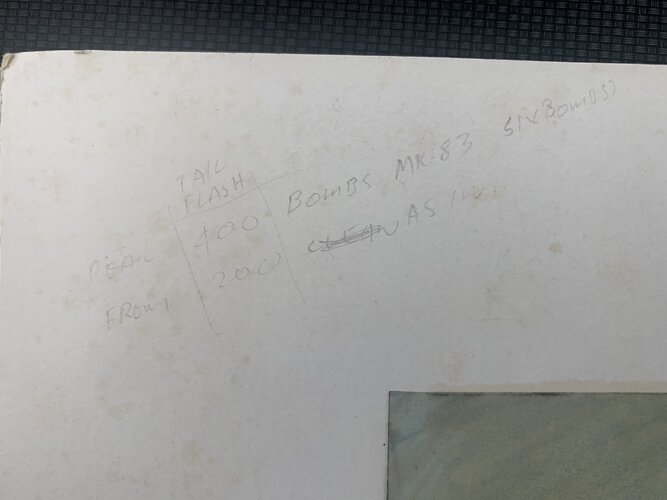
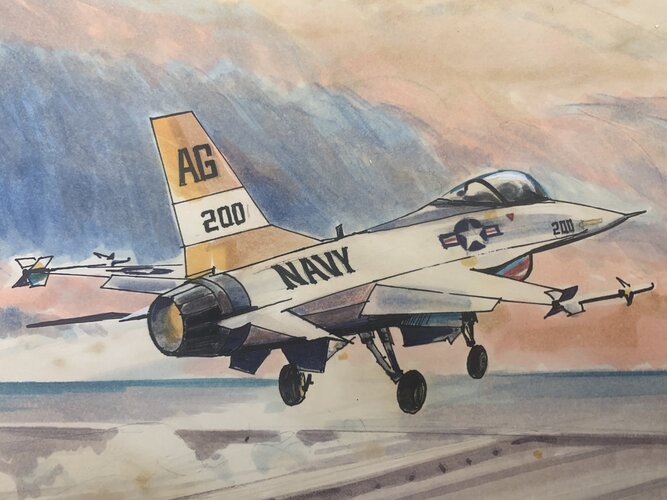
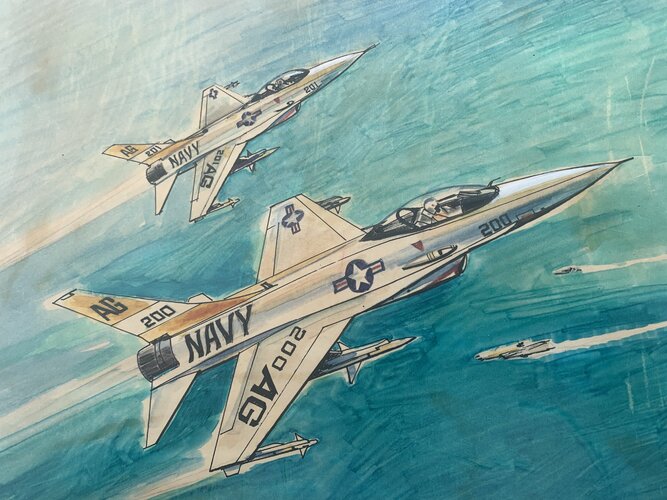
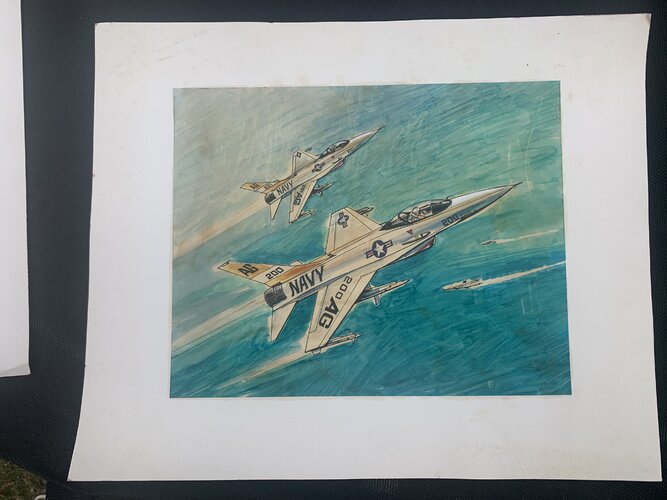
I owned this particular model. It came from GD via a friend, and what makes this interesting was that it was constructed with a vacuum formed fuselage, so it was quite light. I've another F-16 in the same scale that is made the same way. When it came to me it was missing the dual side rails and a tad bit rougher in condition. No stand, it was a wheel sitter. Also note all of the other weapons on the table, and naaaaa, did not have them either.Several interesting things about this image.
1. Model 18 on the vertical does anyone know if this was a General Dynamics designation?
2. The twin AIM-9 mounting on the wing tips.
3. The AIM-9 mounted on the side of the intake. I don't recall seeing this in any of the drawings.
VAHF image.
Several interesting things about this image.
1. Model 18 on the vertical does anyone know if this was a General Dynamics designation?
2. The twin AIM-9 mounting on the wing tips.
3. The AIM-9 mounted on the side of the intake. I don't recall seeing this in any of the drawings.
VAHF image.
